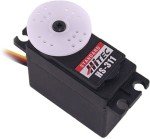TechAmor
For the Love of Technology
TechAmor
A Multi Technology Portal for Tech Enthusiasts
Your Company Address
India

These are another kind of DC motors ,but with a built in gearing Feedbck System. These servo motors come in many varieties and can from 0 to 180 degrees. Some rotate through a full 360 degrees or more.
They are extremely popular with RC plane,boat and Robots with precision handling like arms and legs.
And most of all these do not need any motor drivers circuits
A thing to note is that servos are unable to continually rotate, meaning they can't be used for driving wheels. There is a modification provided to do so at Society of Robots
Method to Drive a Servo
The servo normally has Three wires with it. Connect the black wire to ground, the red to a 4.8-6V source, and the yellow/white wire to a signal generator (such as from your microcontroller). Vary the square wave pulse width from 1-2 ms and your servo is now position/velocity controlled.
READ MORE….

These are another kind of DC motors ,but with a built in gearing Feedbck System. These servo motors come in many varieties and can from 0 to 180 degrees. Some rotate through a full 360 degrees or more.
They are extremely popular with RC plane,boat and Robots with precision handling like arms and legs.
And most of all these do not need any motor drivers circuits
A thing to note is that servos are unable to continually rotate, meaning they can't be used for driving wheels. There is a modification provided to do so at Society of Robots
Method to Drive a Servo
The servo normally has Three wires with it. Connect the black wire to ground, the red to a 4.8-6V source, and the yellow/white wire to a signal generator (such as from your microcontroller). Vary the square wave pulse width from 1-2 ms and your servo is now position/velocity controlled.
About PWM
Pulse width modulation (PWM) is a powerful technique for controlling analog circuits with a processor's digital outputs. It is used in a wide variety of applications, ranging from measurement and communications to power control and conversion. The general concept is to simply send an ordinary logic square wave to your servo at a specific wave length, and your servo goes to a particular angle (or velocity if your servo is modified). The wavelength directly maps to servo angle.The standard time vs angle is represented in this chart:

Pulse for controlling a Servo motor
A Great Deal of matter on This can be Found out at Society of Robots
Driving a Servo
Servo just needs to be given PWM to work and this can be given through various Sources.
We will discuss following methods in the Next Post